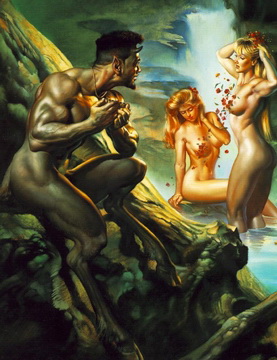In
Roman mythology, fauns are place-spirits (genii) of untamed woodland.
Romans connected their fauns with the Greek satyrs, wild and orgiastic
drunken followers of Bacchus (Greek Dionysus). However, fauns and satyrs
were originally quite different creatures. Both have horns and both
resemble goats below the waist, humans above; but originally satyrs had
human feet, fauns goat-like hooves. The Romans also had a god named Faunus
and goddess Fauna, who, like the fauns, were goat-people.
In
Greek mythology, satyrs (Ancient Greek:
Σάτυροι, Satyroi) are a troop of male
companions of Pan and Dionysus — “satyresses” were a late invention
of poets — that roamed the woods and mountains. In mythology they are
often associated with sex drive and vase-painters often portrayed them
with perpetual erections.

Mr. Tumnus, a faun from the
movie “The
Chronicles of Narnia"
The
satyrs’ chief was Silenus, a minor deity associated (like Hermes and
Priapus) with fertility. These characters can be found in the only
remaining satyr play Cyclops by Euripedes and the fragments of Sophocles’
The Tracking Satyrs (Ichneutae). The satyr play was a lighthearted
follow-up attached to the end of each trilogy of tragedies in Athenian
festivals honoring Dionysus. These plays would take a lighthearted
approach to the heavier subject matter of the tragedies in the series,
featuring heroes speaking in tragic iambic verse and taking their
situation seriously as to the flippant, irreverent and obscene remarks and
antics of the satyrs. The groundbreaking tragic playwright Aeschylus is
said to have been especially loved for his satyr plays, but none of them
have survived.
